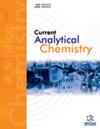A Simple and Novel Technique for the Determination of Rhodamine B in Cosmetics Based on Dispersive Surfactant Micelle-mediated Extraction and Image Colorimetric Analysis
IF 1.7
4区 化学
Q3 CHEMISTRY, ANALYTICAL
引用次数: 0
Abstract
Aims: The primary objective of this study was to develop a simple, selective, sensitive, and rapid method for the determination of trace levels of Rhodamine B in different cosmetic items. Background: At present, synthetic dyes in various colors are essential in cosmetic products, not only for adding pleasant scents, but also for enhancing their appeal and restoring natural colors. Rhodamine B, a pink synthetic azo dye, is widely used in the cosmetic industry. It poses risks if ingested by humans and animals, causing skin, eye, and respiratory irritation. Scientific studies have shown that it has carcinogenic, reproductive, developmental, neurotoxic, and chronic toxic effects on both humans and animals. Therefore, the improvement of precise and fast measurement techniques for detecting Rhodamine B in different sample types is crucial. Objective: The objective of this study was to find a fast, accurate, and sensitive method for the determination of trace levels of Rhodamine B in different cosmetic items. Methods: The technique used has been based on Dispersive Surfactant Micelle-mediated Extraction (DSME) combined with digital image analysis. Results: The optimized method yielded a linear calibration graph ranging from 25 to 300 μg L-1, with a correlation coefficient of 0.9975 and the Limit of Detection (LOD) of 6.7 μg L-1. The proposed method was used to measure Rhodamine B in lipstick and nail polish samples, resulting in satisfactory recoveries ranging from 97.8 to 107.2%. Conclusion: DSME could remove the necessity of high temperature, hazardous organic solvents, and anionic surfactants in Cloud Point Extraction (CPE) and Catanionic Surfactants-based Coacervation Extraction (CSCE). Additionally, experiments have shown the results from digital image analysis to be in line with those from a commercial UV-Vis spectrophotometer and a spectrofluorometer. The authors believe that utilizing DSME image analysis could be a beneficial alternative to the analytical analysis of other colored species in routine analysis.一种基于分散表面活性剂胶束介导的萃取和图像比色法测定化妆品中罗丹明 B 的简单而新颖的技术
目的:本研究的主要目的是开发一种简单、选择性强、灵敏而快速的方法,用于测定不同化妆品中罗丹明 B 的痕量含量。研究背景目前,各种颜色的合成染料在化妆品中必不可少,它们不仅能增加化妆品的香味,还能增强化妆品的吸引力,恢复化妆品的天然色彩。罗丹明 B 是一种粉红色的合成偶氮染料,被广泛用于化妆品行业。如果人和动物摄入,会对皮肤、眼睛和呼吸系统造成刺激。科学研究表明,它对人类和动物都有致癌、生殖、发育、神经毒性和慢性毒性作用。因此,改进精确、快速的测量技术以检测不同类型样品中的罗丹明 B 至关重要。研究目的本研究旨在寻找一种快速、准确、灵敏的方法来检测不同化妆品中罗丹明 B 的痕量含量。方法:采用分散表面活性剂胶束介导萃取(DSME)技术,并结合数字图像分析。结果优化后的方法得到了从 25 μg L-1 到 300 μg L-1 的线性校准图,相关系数为 0.9975,检出限(LOD)为 6.7 μg L-1。该方法用于测定口红和指甲油样品中的罗丹明 B,回收率在 97.8% 至 107.2% 之间,结果令人满意。结论DSME 可以避免在浊点萃取(CPE)和阴离子表面活性剂凝聚萃取(CSCE)中使用高温、有害有机溶剂和阴离子表面活性剂。此外,实验表明数字图像分析的结果与商用紫外可见分光光度计和分光荧光计的结果一致。作者认为,在常规分析中,利用 DSME 图像分析可以替代对其他有色物种的分析。
本文章由计算机程序翻译,如有差异,请以英文原文为准。
求助全文
约1分钟内获得全文
求助全文
来源期刊

Current Analytical Chemistry
化学-分析化学
CiteScore
4.10
自引率
0.00%
发文量
90
审稿时长
9 months
期刊介绍:
Current Analytical Chemistry publishes full-length/mini reviews and original research articles on the most recent advances in analytical chemistry. All aspects of the field are represented, including analytical methodology, techniques, and instrumentation in both fundamental and applied research topics of interest to the broad readership of the journal. Current Analytical Chemistry strives to serve as an authoritative source of information in analytical chemistry and in related applications such as biochemical analysis, pharmaceutical research, quantitative biological imaging, novel sensors, and nanotechnology.
 求助内容:
求助内容: 应助结果提醒方式:
应助结果提醒方式:


